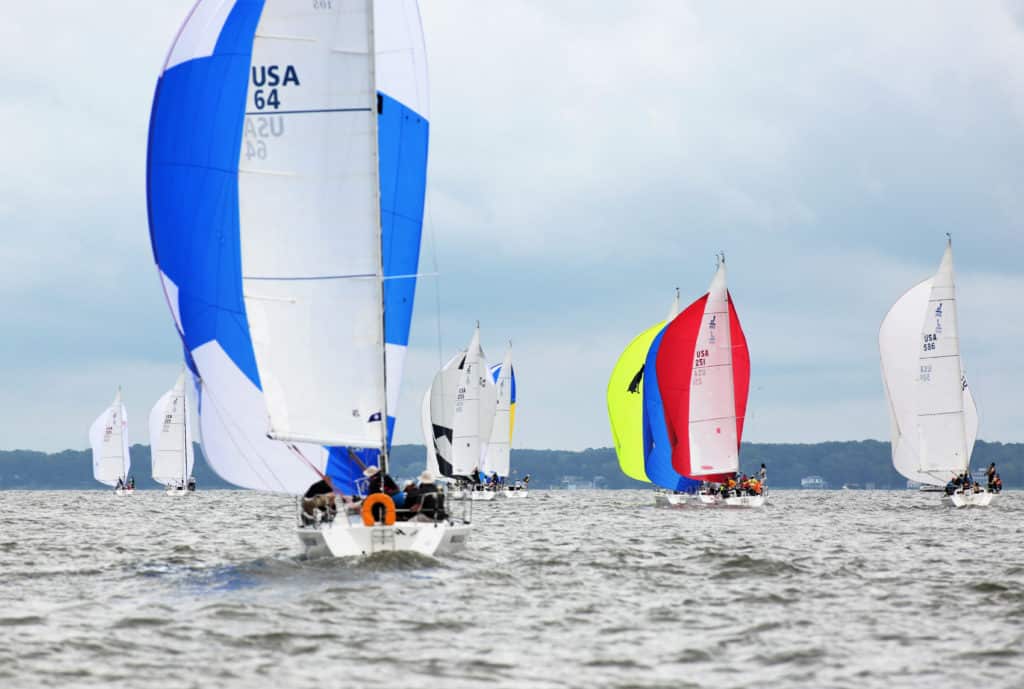
If you believe there’s a silver lining in every cloud, you probably don’t mind too much when other boats get ahead of you. That’s because you know that working your way up through the fleet can be one of sailing’s most exhilarating challenges. I have to admit I’m never too thrilled about being in the middle of the pack. But once I readjust my frame of mind to that position, I get psyched to catch as many boats as possible.
Almost every sailor has a favorite story about a race when they were 25th at the windward mark and finished in the top five. Unfortunately, there are many more untold stories about being 25th at the first mark and ending up 25th. These are living proof that making the great comeback is not always a piece of cake. In fact, passing other boats can be quite difficult and requires many different skills.
Whether you are trying to get past one boat or a dozen, the key is composure. Don’t lose your cool. Or, if you lose it, at least try to get it back as soon as possible. Suddenly seeing half the fleet in front of you is a bit unsettling; but this is exactly the time when you need every ounce of mental sharpness to start a comeback.
One of the toughest things about being behind is losing the freedom to sail where you want. When you’re surrounded by dirty air, choppy water, and a bunch of right-of-way boats, it’s tough to keep your boat up to speed, much less play the windshifts. Therefore, you have to work extra hard at staying in control of the race. Don’t let other boats dictate your strategy.
Sailing your own race is the surest way to get past the competition. So, stick to your well-thought-out plan. If you minimize mistakes for the rest of the race, you can count on many of your competitors to make the errors that will put them behind you. Whatever you do, don’t take chances. When you’re deep in the pack, you can’t afford to risk losing any more boats or distance: Sail conservatively and choose high-probability options.
In general, go for small gains rather than big ones. While it’s tempting to shoot all your marbles at once, you have to be patient. Try to pick off one or two or three boats each leg rather than a whole pack. This will force you to sail smartly and consistently.
Remember that, early in the race, making up distance can be at least as important as gaining places. So, don’t focus only on the boat just ahead. On a reach, for example, it’s probably better to stay in 15th place and sail the rhumbline than it is to gain one boat by sailing high and losing distance to all the leaders.
At the same time, you don’t want to get stuck behind a slow boat. There’s nothing more frustrating than watching the leaders sail over the horizon while you’re plodding along in second gear. If it looks like you’re coming up to a slow boat, plan ahead on how you will get around him. Here are some specific passing ideas for different legs of the course.
Passing on a windward leg
When you’re sailing upwind, the boats ahead have a significant advantage because they can use their wind shadow to slow or control the boats behind. Therefore, when you’re behind on a beat, maintain clear air. Make sure you look ahead for clear-air “lanes” on the other tack. If you have to sail in bad air, it will be tough to move up in the fleet.
Fortunately, beats offer a number of opportunities for getting by other boats. First of all, boatspeed is more critical here than anywhere else. If you can point a little higher or go a little faster than your competition, it’s just a matter of time before you will pass them. Get into a groove and focus on speed.
“My rule of thumb is that your distance from other boats should be proportional to your confidence in what the wind will do.”
Beats also allow you to split tacks. By sailing away from the boats ahead of you, you buy “leverage” that will help you gain on them in a favorable windshift. This is probably the most common way of changing positions upwind. Of course, the farther you split apart the more you risk losing as well; my rule of thumb is that your distance from other boats should be proportional to your confidence in what the wind will do.
One of the fringe benefits of being behind on a beat is that you can use other boats as wind telltales to predict what the breeze will do. When you see a boat ahead sail into a hole, for example, you can often tack and sail right around them. You just have to keep your eyes open and watch all the clues.
Passing on a reach
It’s difficult to improve your position on reaches because most boats go roughly the same speed, and they all sail basically the same course. When you’re behind, unfortunately, you don’t have the option to split tacks; and getting by another boat usually means you have to sail way high or low of the straight-line course to the mark.
There are certain situations, however, when you can gain enough of a speed advantage to have a good chance of passing boats ahead. These include light- or heavy-air, broad reaches in shifty or puffy winds. In these conditions, you want to get up into the “passing lane” early.
On a highway, the fastest cars move to the extreme left lane so they can pass the slower vehicles. On a reach, the fastest boats move several boatlengths to windward of the boats ahead and pass from there. The reasons for this are two-fold: First, you want clear air and water so you can steer a fast course up and down without interference. Second, you want to be far enough from the slower boats so they aren’t tempted to head up and luff you.
The basic rule of thumb on reaches is to avoid sailing low. In most cases, sagging to leeward will put you in the bad air of boats ahead, and you risk being run over by a train of boats coming from behind. The only times you have a chance to pass boats by going low are when a) the reach is quite broad; b) the wind is dying; c) there are no boats right behind you; d) the boats ahead are going quite high; or e) you’re near the end of the leg going for inside position at the mark.
Passing on a run
The run is one of the most enjoyable parts of the race when you’re behind, because you not only have the option to split jibes, but you can also use your wind shadow to attack boats ahead. First, make sure you re sailing on the right jibe. In general, stay on the jibe that takes you closer to the leeward mark and/or the jibe that is headed. By doing this, you will gain on all boats that make strategic mistakes.
Your second priority is to use your wind shadow to slow and pass the boat(s) directly ahead of you. To do this, line up directly on the apparent wind of the boat ahead by looking at the wind pennant on top of the other boat’s mast. When you see the other boat’s spinnaker start to go soft, you know you’re in the right place, and it’s just a matter of time before you slide by.
Just remember when you’re passing boats to set your sights on the fleet ahead, and don’t look back. If you sail aggressively and minimize mistakes, you will continue to move up through the fleet. It’s only when you start worrying about the boats behind that you stop gaining.
Buddy Melges is fond of saying you should “start first and increase your lead.” This is great advice, but most of us have a hard time following it. More often we are fighting to get past the boats ahead. But the challenge is fun, and we learn a lot. And after all, learning how to sail better is a major goal and reward of every racing experience.









